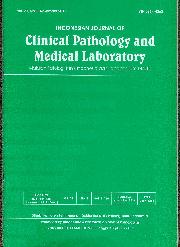Indonesian Journal of Clinical Pathology and Medical Laboratory
ISSN 0854-4263
Vol. 21 / No. 1 / Published : 2014-01
Order : 13, and page :61 - 66
Related with : Scholar Yahoo! Bing
Original Article :
Brain derived neurotrophic factor (bdnf) as a prognostic factor in severe head injury
Author :
- Ridha Dharmajaya*1
- Bedah Saraf Fakultas Kedokteran Universitas Sumatera Utara, Medan
Abstract :
Severe head Injury result in primary and secondary brain damage. The secondary brain damage produces a more worse effect than the primary one. Therefore, the process of the secondary brain damage should be prevented in order to obtain a maximum result of patient management. The difficulty is to make sure, whether the secondary brain damage is already very bad or, on the other hand, is still in a positive condition, causing patient management to have a good result. The prognostic decision, is the most important thing in patient management. The objective of this research was to find an accurate prognostic factor which is simple and non invasive for severe head injury for each time lapse, 24, 48, 72 and 120 hours after the brain damage which had caused the head injury. The installation of an intracranial pressure (ICP) monitor for the first 24 hours, after the head injury, followed by taking a cerebrospinal fluid sample for BDNF examination at the first 24 hours, 48 hours, 72 hours and 120 hours as well. Enzyme Linked Immunosorbent Assay was used to determine BDNF. Each subject was assessed by Glasgow Outcome Scale classification, three months after the injury. The result of this research was that BDNF at 48 hours after head injury showed a significant difference (p < 0.05) between good and bad Glasgow Outcome Scale classification. Thus, it can be concluded that patients with an increase in BDNF (>6.16 pg/mL) 48 hours after head injury, may have a good prognosis. Kasus cedera kepala berat didapati ada tingkat primer dan sekunder. Kejadian cedera kepala sekunder menimbulkan dampak yang lebih berat dibandingkan dengan yang primer. Proses cedera kepala sekunder harus dicegah untuk mendapatkan hasil mengobati yang terbaik. Di samping itu ada kesulitan untuk menentukan apakah cedera kepala sekunder ini sudah begitu berat, sehingga pengobatan akan memberikan hasil yang percuma atau cederanya ini masih dalam tahap yang layak untuk ditolong, agar memberikan hasil yang baik. Dalam tatalaksana pengobatan diperlukan penentuan peramalan perjalanan penyakit yang teliti. Penelitian ini bertujuan untuk mendapatkan pengetahuan faktor peramalan perjalanan penyakit yang teliti, mudah dan tidak invasif bagi pasien cedera kepala berat dengan cara membandingkan kekuatan dari waktu, yaitu setelah 24, 48, 72 dan 120 jam mendapat cedera. Di subjek penelitian ini dipasang monitor tekanan intrakranial pada 24 jam pertama pascacedera kepala. Pengambilan sampel cairan serebrospinal, untuk pemeriksaan Brain Derived Neurotrophic Factor (BDNF) dilakukan dalam empat kesempatan, yaitu pada 24 jam, 48, 72 dan 120 pascacedera kepala. Pengukuran BDNF dilakukan dengan menggunakan Enzyme linked immunosorbent assay. Seluruh subjek penelitian dinilai derajat hasilannya dengan menggunakan penggolongan Glasgow Outcome Scale (GOS) setelah tiga bulan pascacedera kepala. Hasil mengukur BDNF 48 jam pascacedera kepala, menunjukkan perbedaan yang bermakna, yaitu p<0,05 dalam menentukan GOS baik atau GOS buruk. Berdasarkan kajian ini dapat disimpulkan bahwa penderita dengan peningkatan BDNF pada 48 jam pasca trauma (>6,16pg/mL), memiliki peramalan perjalanan penyakit yang baik.
Keyword :
Brain derived neurotrophic factor, prognostic factor, severe head injury,
References :
Soemantri S, Budiarso LR, Sandjaja,(2004) Status Kesehatan Masyarakat Indonesia Hal : 34-36 : Survey Kesehatan Nasional, Badan Penelitian dan Pengembangan Departemen Kesehatan Republik Indonesia
Servadei F, Merry GS.,(2004) Mild Head Injury in Adults Ed ke 5., Vol IV. Hal : 5065-5081. : Dalam: Winn HR editor. Youmans: Neurological Surgery
Archive Article
| Cover Media | Content |
|---|---|
 Volume : 21 / No. : 1 / Pub. : 2014-01 |
|













